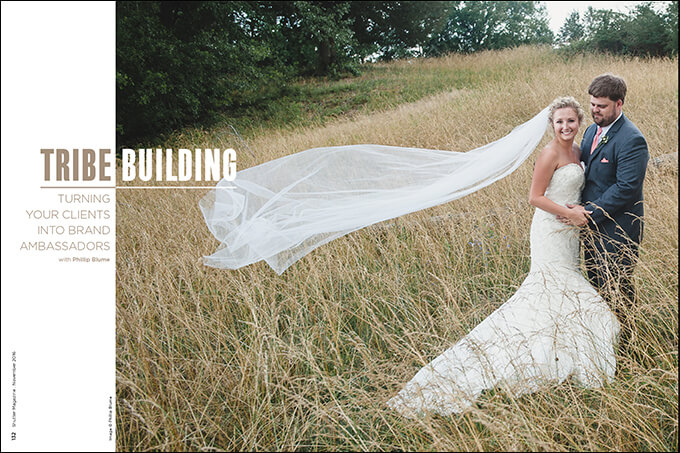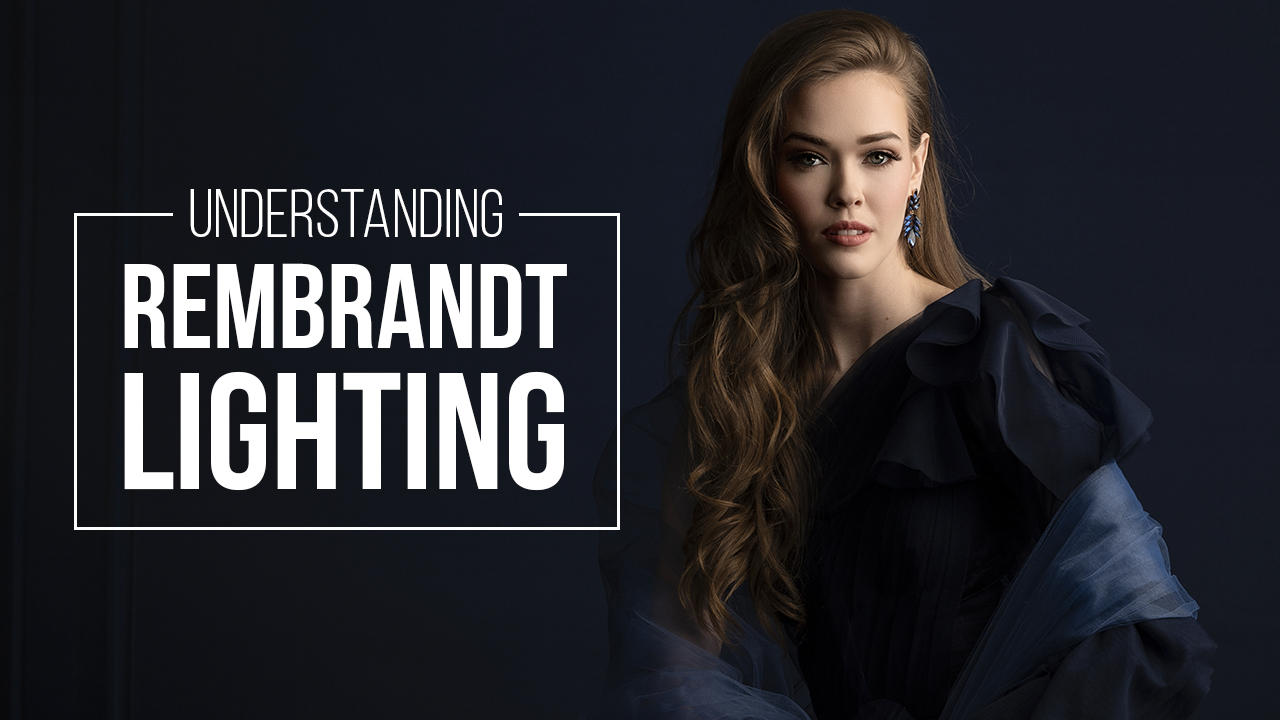Tribe Building: Turning Your Clients Into Brand Ambassadors with Phillip Blume
How would you like your photography business to enjoy an almost unfair advantage in the marketplace? What if your clients swore by your brand? Sounds too good to be true, right? Now get ready for a shock. If that kind of brand advantage sounds like an unattainable dream to you, it’s not. It may seem far away, but that’s only because you’ve become accustomed to the dismal alternative: You’re grasping wildly for every client, drowning in a sea of photographers whose bargain rates make it impossible to compete and still stay afloat financially. Sound familiar?
That’s not your market’s fault. It’s your fault.
I realize that feels harsh. True, I don’t know you or your market, and I apologize if I’ve bruised any egos. But I can tell you what I do know (and remember, I’m only here to help).
I know how my wife and I steered our rural home studio (which serves a small market with America’s highest poverty rate) to national prominence and award-winning financial growth. I know the breakthroughs of many photographers we’ve coached over the course of our eight years in business, and I’m inspired by their successes in difficult markets all across the country, where they’re using our same common-sense approach.
We aren’t doing anything fancy or new. While there are many links in the “chain” of your business, you can sum up our approach and begin to strengthen all those links with one phrase: tribe building. Here’s how it works.
- Your tribe must be exclusive.
The biggest mistake we see photographers make all the time is trying to market to everyone. Be honest. Have you ever left a pile of business cards in a coffee shop? I have. In fact, my definition of “vendor relationships” once consisted of little more than asking to leave our cards in vendors’ shops all over town. One of those shops directed us to their bathroom, where they had a small table dedicated to this desperate marketing “strategy.” It was piled up high. Virtually everyone markets poorly. This is partly why your advantage grows exponentially when you begin to shift your brand’s focus.
Looking back now, I wonder what I was thinking. Did I really want a potential client to fill out our contact form like this? “I found your logo and phone number on a soggy piece of paper beneath my foot while I was sitting on the toilet.” Very classy. As Simon Sinek concludes in his popular TED Talk, the goal of every extraordinarily successful business is not to do business with everyone: “The goal is to do business with people who believe what you believe.”
That idea alone is powerful enough to guide your new branding strategy. As I often say, your brand’s job is not to find just any client; your brand’s job is to find your client. So who is your client? Your client is someone you’re capable of connecting with on a human level, someone who believes what you believe. My friend Mike Allebach is a great example. He likes tattoos and loves people. He’s had huge success branding himself as the “tattooed bride photographer,” and hip, alternative clients flock to him from all over. He brands to his client. As a result, they connect over deeper issues than just photography. Mike actually enjoys his clients. Doesn’t that sound like a bonus?
When I encourage you to create an exclusive tribe, I’m not suggesting you create a social clique. You should still feel free to serve anyone who walks through your door. But prepare yourself. When you brand more intentionally, the majority of your inquiries will begin to pour in from a very exclusive market segment—people like you. These are highly qualified leads.
Take our company, Blume Photography, for example. We like to imagine clients choose us because we’re the best, most talented photographers in the world. But most of our clients don’t read photo magazines. They don’t know who we are and don’t care a smidgen about the stylistic differences between us and the next photographer. However, by the time they’ve visited our website and read our first email reply, they know without a doubt that we believe in two things: marriages (not just weddings) and giving back via personal projects to fight poverty. The clients who sign our contracts are signing on for something bigger. They tend to be people who give to charity. They understand their investment in us results in more than just pictures—it serves our shared values.
Photography is shallow. I can already hear the sound of panicked typing as some of us rush to change our website’s About pages. No more “Photography is my life” garbage. It’s time to replace that mumbo jumbo with something you really care about. It’s not your camera; it’s the human people in front of it that matter most.
- Your tribe must feel well served.
Once you start getting inquiries from your ideal clients, you’d better make good on your promises. They hired you because they believed in you, so the experience you provide better represent the same you that’s portrayed online.
This is where sincerity becomes crucial to your brand. There’s nowhere to hide. Most of us have heard the truism “You are your business.” If you’ve chosen a brand message you think will be successful in your market but it isn’t authentically you, good luck keeping up the charade. It will prove impossible.
My wife and I have a great sense of humor. But we are not those wedding photographers who laugh at a joke about divorce being good for repeat business. You will likely feel awkward if you deliver that joke around us, because we won’t crack a smile. Our passion for lasting marriages is authentic. As a result, we’ve received emotional letters and even dinner invitations from former brides whose marriages sadly did not work out. We’ve cried on the phone with another bride after her parents separated. No, we can’t fix those tragedies. But we were there for our clients on a personal level that affirmed what we believe in. If we weren’t passionate about this, it would become an emotionally exhausting part of our job—not worthwhile and, frankly, undoable.
More importantly, we encourage young couples to invest in their relationship, because we know that love needs to be nurtured to last. Within our brand, that shows up in everything from the meaningful gifts we give our clients to the words of wisdom we pepper throughout our communication and workflow. Maybe that is why our clients feel comfortable sharing not only the happiest, but also some of the most difficult moments in their lives with us. We’ve asked ourselves the obvious question: We love our clients, but why would they think to call us when they surely have closer friends in their lives? As Dale Carnegie wrote in his classic How to Win Friends and Influence People, “So many people are grasping and self-seeking, the person who seeks selflessly to serve others has an almost unfair advantage in the marketplace.”
Here’s how I like to illustrate it: Your personal destiny and business destiny are intertwined. Neither destiny is determined by the invisible winds of economic turmoil or changing markets. Instead, your destiny is decided internally by your own perspective—what will you value and be content with? It’s also defined externally by your tribe. Your tribe will support you to the extent that you value and serve them.
Market research shows that consumers who support values-focused brands (termed “neos” in one study) are incredibly reliable even in the worst economic times. This phenomenon explains why values-focused brands like Apple (whose values are innovation, art and user experience, not just computing) consistently break sales records without offering discounts even in historically bad economies. Yet other companies with almost identical structures and products (whose brands, however, consist of little more than a famous logo and a catalogue of products) struggle or go out of business during the same periods. An ever-growing number of neo consumers, who represent the vast majority of all purchasing power, as it turns out, actually buy fewer things during hard times so they can continue buying the select luxuries they feel are more meaningful or unique, or that create an extraordinary experience. This is great news for artists.
These studies make perfect sense. Consumers aren’t robots. They are people. Our lives are short, and yet we at least seem to be designed with some inherent (dare I say “spiritual”) understanding that our lives are meaningful. Materialism be damned. Serve your tribe well, and even your mistakes and shortcomings will be forgiven by adoring brand evangelists.
- Your tribe must be connected.
I sat in the garage for 30 minutes listening to the car radio. The program was describing a simple concept known as “Dunbar’s number.” Its practical applications for business fascinated me. Dunbar’s number isn’t precise, but it floats around 150—the typical number of people in a literal “tribe” and, as it happens, the same limited number of people our human brains are capable of cataloguing as “intimate connections.” Dunbar’s number is a lot smaller than the number of our Facebook friends. We all know Facebook friends aren’t all real friends. We’re just now learning how few real friends we’re really capable of having. The number is limited by biology.
Keep this in mind as you brand and market yourself. Photography businesses are obsessed with SEO and social media, how many “likes” they can get. But what if numbers don’t matter as much as we think they do? My talented friends at Anna & Spencer Photography have maintained their status on Google’s first page under “Atlanta photographer” and other keywords for years. Yet, as Spencer told me, that prized position shockingly results in just a couple dozen clicks per day—nothing compared to the huge number of referrals their down-to-earth, human-driven word-of-mouth marketing creates. It is the human referrals, not the algorithmically generated promotion, that translates into more new clients.
To hear more about the powerful ways we’re connecting our clients together as a tribe and earning referrals at Blume Photography, watch this video. To join me and Eileen for a free 30-day marketing challenge that will change how you market, sign up now at www.blumephotography.com/blog/30-days-to-different.




